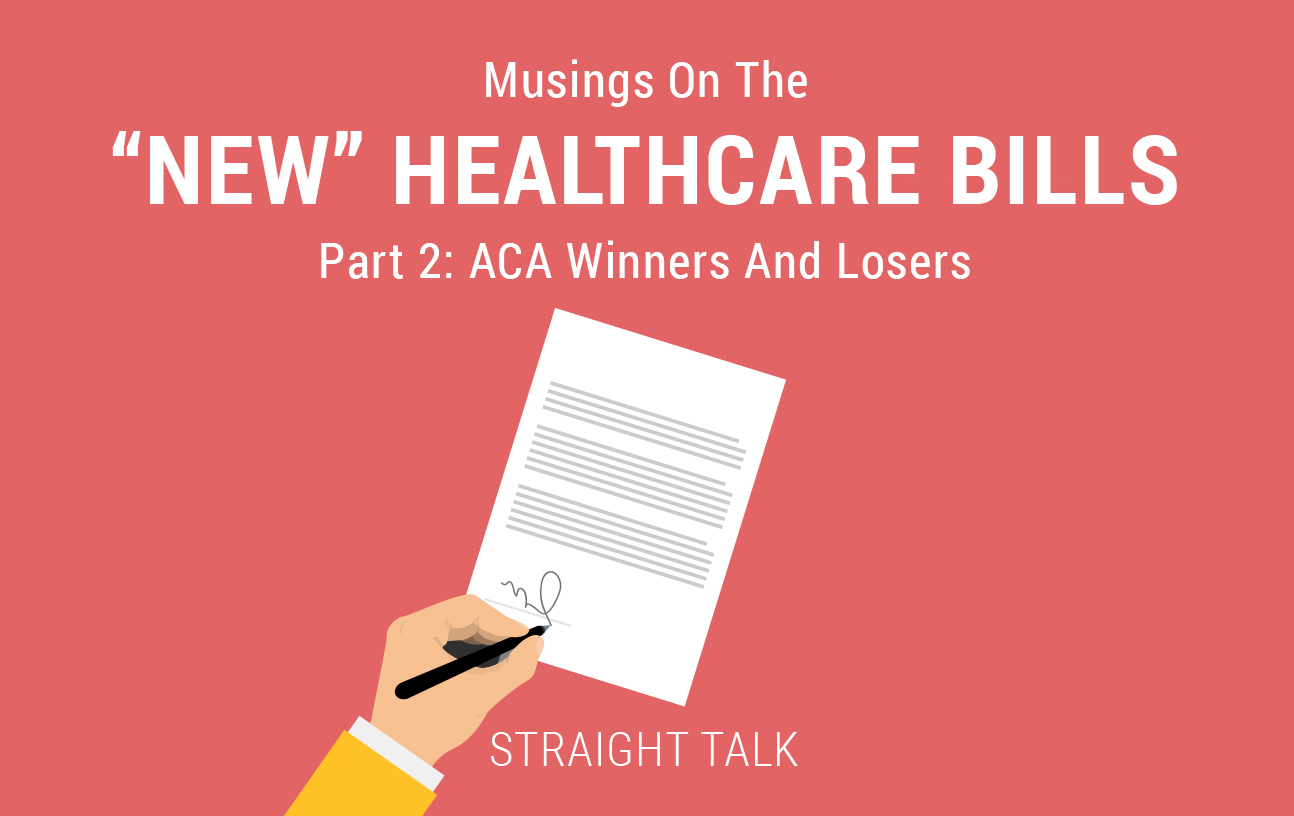Last week, we began trying to explain why these new “Repeal and/or Replace” healthcare bills are so prominent in the political universe and so important right now. We began that discussion with a short history lesson on the Patient Protection and Affordable Care Act (PPACA or ACA), and now we know that a massive re-regulation and federalization of the individual health insurance market was the root of the opposition who are now trying to pass the current healthcare bills.
Who Won and Who Lost in 2010’s Law?
In that blog, I said that the ACA created clear winners and losers. The winners are pretty easy to find:
- Low-to-mid-income folks, especially those with severe health conditions who got access to either Medicaid or heavily subsidized individual health insurance.
- Medical providers of all stripes, who gained millions of new customers, either high-paying privately insured clients or formerly uninsured Medicaid patients.
- Progressive healthcare policymakers, who typically favor centralized solutions and deficit spending.
- Majority “Blue” states that were already using state revenue to cover more people under Medicaid and were able to shift substantial amounts of this state spending to the federal government at 90-100% match rates.
We can divide those who feel like they “lost” under the ACA into big categories as well:
- Those who really liked the insurance they had before.
- Those whose rates have skyrocketed under the ACA, particularly the younger and healthier portions of the population
- Those who object to the federalization of the act and any law that says they must buy health insurance or pay a fine.
- Those affected by the taxes and fees that help fund the act, including:
- All people who buy health insurance or healthcare
- All businesses that buy (or fail to buy above 50 full-time employees’) health insurance
- Medical device manufacturers and their customers
Let’s take the disadvantaged population one at a time:
Those Who Liked The Insurance They Had Before
First, many millions of Americans, on the eve of the ACA’s passage, actually had individual policies they liked. Because of the tremendous variations from state to state, these people were difficult to quantify and find. Here at Blue Cross, we know we had 125,000 customers with individual policies who were dialing their own risk to gain policies they could afford. Some clients just wanted hospital-only coverage. Some wanted to add in a few doctor visits each year. Some wanted comprehensive coverage without expensive add-ons (like maternity).
Others wanted the kitchen sink. We sold all of those policies at a variety of prices to suit the customers’ needs. We had a stable population who stayed with us for an average of 47 months.
Our current population is so unhappy with their choices that only 40% of them pay 12 premiums in a row. While true that not every single person who applied with us was approved for coverage in the past, because we had limited ability to “rate up” higher-risk individuals, we were able to sell coverage to most applicants that they could afford and felt was good enough to keep for an average of almost four years.
We even had accommodations for families, only charging three premiums (two adults plus one child) no matter how big the family was. In the quest to make the market fairer, the ACA’s authors decided that coverage was the most important thing and set about to standardize a federal definition of that coverage at a high level.
They even called most of the existing coverage “junk” publicly to emphasize their position. Implicit in that definition was the belief that the average person was not capable of dialing his own risk, so they made selling any policy below the new, federal standard illegal. Every policy sold on the marketplace today has very broad coverage that does not change based on age, gender or necessity.
Those Whose Rates Have Skyrocketed
Second, you might ask, “Mike, why did rates for some people skyrocket under the healthcare reform law?” Our individual rates are roughly double what they were on 12/31/2013 (the law took full effect in 2014).
In general, rates went up because the federal government did not enforce all the rules or overcome design flaws of the original act:
- Poor decision-making in drafting the ACA caused politically skewed age-ratings, driving out the young and the healthy in favor of the old and the sick. Rates UP
- An individual responsibility requirement (the individual mandate that requires everyone to be insured) weakened by 29 exemptions does not motivate most people to actually buy coverage as it was supposed to do. Rates UP
- Families with more than three people had to pay five premiums or more to cover their entire family. Prior to this law, three premiums was the typical family rate. Rates UP
- Poor oversight of Special Enrollment Periods allowed people to buy coverage after they got sick from January 2014 through June 2017. Rates UP
- Poor oversight and the threat of disappearing Cost-Sharing Reductions have driven out many carriers from the Marketplace, lowering competition. Rates UP
If you add up all these disadvantaged people, you’ve got a pretty big basket of folks pining for a repeal of the current healthcare law. They might even dream of going back to the way things were, but putting that genie back in the bottle may be impossible. We’ll talk about that later.
Those Who Object To The Law’s Elements
Third, I’ve noticed a lot of the political opposition to the ACA, from Congressmen who promised to repeal and replace it and were elected largely by the people in the “losing” groups listed above, takes the form of an argument over states’ rights and the federal government’s inability to stabilize the individual markets thus far.
Of course, I’m not being overwhelmed with evidence that any of the new proposals will stabilize anything, either, but the root of the opposition in this category I think is best expressed in this statement:
- “This Bill does not roll back all the new authority given to Washington D.C. back in 2010. I won’t vote for it.” (Jeff Duncan R-SC)
Congressman Duncan was speaking in large part for the Freedom Caucus in the Republican Party, and I’ve heard similar sentiments from the Senate in the past few weeks. It’s a tacit recognition that those who oppose the ACA believe all of the new federal authority in the original act might not have been well-used. That argument can’t be explored here, but it doesn’t matter what I think about that; if 50+ Senators think that way, change is going to come.
If these attitudes are pervasive in the party currently in power, it’s pretty easy to see why the House and Senate repeal/replace bills came to be and continue to be an issue.
Those Affected By Taxes and Fees
And finally, my business clients remind me every day of all the new hoops they must jump through since 2010 to even offer coverage to their employees. They say they are swamped with new regulations on pricing, coverage, all the new expensive reporting they have to do and the new computations and audits they are enduring because of the ACA are wearing on them.
Based on those conversations, it wouldn’t take much to believe that they would be strongly in favor of any legislation that would reduce that burden on them.
If you think about the groups I’ve defined above as “losers” under the ACA, it’s not hard to understand how opposing or resetting it could have become a movement and led to an attempt at housecleaning in Washington, D.C.
The guys who started healthcare reform way back in 2008, culminating with the ACA’s passage in 2010, probably didn’t realize they were kicking this many ant hills, but now the pendulum is swinging back the other way, and the outcome this time could be very disruptive, creating new groups of winners and losers.
More Straight Talk about that coming in installment #3 of this series.





Leave a Reply